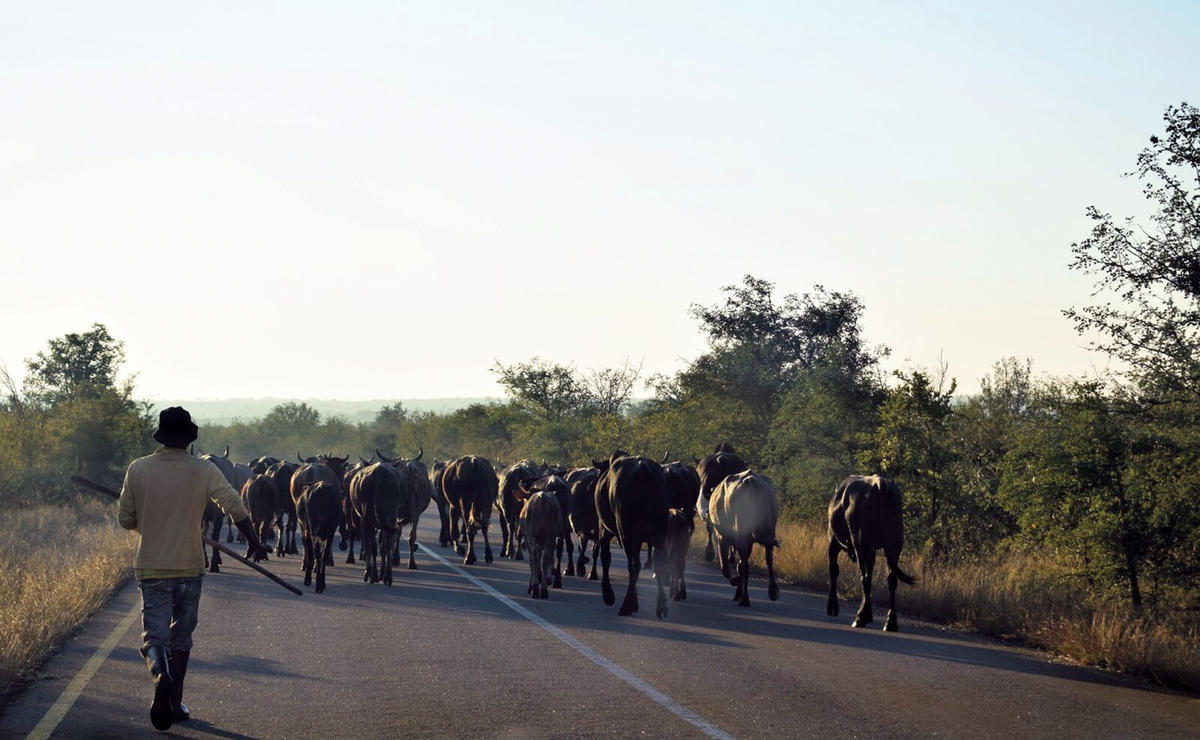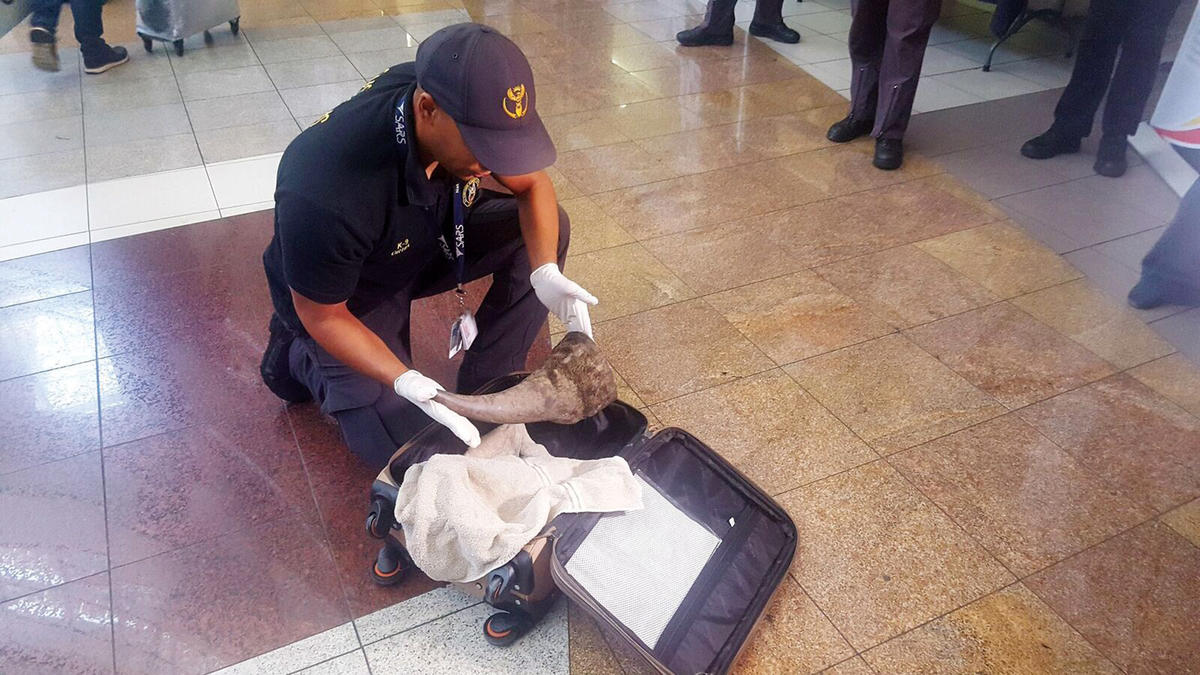Khetha: Bringing “Choices” to Help Address Wildlife Trafficking
An innovative USAID-supported program invites communities around protected areas to play a critical role.
BY LARA RALL

Representatives of the Water Stewardship Programme, supported by the World Wide Fund for Nature and SANParks, make a field visit to a vegetable farm in Belfast, near Kruger National Park. The programme enables farmers to access water from the river inside the park.
Wildlife trafficking is one of the most profitable areas of the global black market and one that is becoming more entrenched in transnational organized crime syndicates operating locally, nationally and internationally. The two traditional approaches to combating this scourge—law enforcement and denial of markets—are now being complemented by a critical third: the organization and empowerment of communities adjacent to wildlife sanctuaries to assist in the preservation of this invaluable source of natural diversity and vital part of Earth’s ecosystem.
Scope of the Illegal Trade
Hundreds of thousands of live animals and wildlife-derived products are illegally traded, amounting to an annual total estimated value of between $8 billion and $10 billion. The effects of wildlife trafficking are far-reaching. Poaching results in the decline of animal populations, which in turn can cause the degradation of whole ecosystems. The proliferation of syndicates associated with the illegal wildlife trade promotes corruption, undermining not only state security but also the economies and development of affected countries—especially those with sectors that rely on wildlife, such as nature-based tourism.
Poaching of elephants for their ivory and rhinos for their horns are some of the most evident representations of the illegal trade in high-value wildlife products. The Great Limpopo Transfrontier Conservation Area (GLTFCA) is rich in biodiversity, encompassing the world-famous Kruger National Park in South Africa, Limpopo National Park in Mozambique, Gonarezhou National Park in Zimbabwe and associated private or community-owned protected areas. With more than 80 percent of Africa’s rhinos, South Africa—and Kruger National Park, in particular—has borne the brunt of the upsurge in rhino poaching incidents since 2008.
Over the past three years, there has been a slight decline in the number of rhinos poached—from a national record of 1,125 animals during 2014 to 1,028 in 2017, of which almost half were killed in Kruger National Park. While the slight decline in KNP is encouraging, there appears to be a shift to poaching of other species, as well as in other areas, such as the KwaZulu-Natal province of South Africa. The increase in elephant poaching in KNP to 67 elephants in 2017 from 46 in 2016 is particularly concerning. The GLTFCA also reports an increase in wildlife poisoning incidents, which have a detrimental impact on vultures and other species.
Many of the communities living in and around wildlife refuges have a complex relationship with park management.
A Complex Problem

Water Stewardship Programme representatives inspect a pump located within KNP that irrigates a local farmer’s land.
However, the effects of wildlife trafficking run deeper than the animals lost; the practice also harms the people who live in or near affected areas. Rural communities living close to protected areas are often perceived as part of the problem; they are believed to be taking part in or indirectly facilitating the illegal activities. In reality, many members of rural communities are negatively affected by wildlife trafficking syndicates. Exposure to illicit trafficking networks and the influx of illegal funds can lead to social instability, with repercussions such as increased drug and alcohol abuse and the sexual exploitation of women.
Many of the communities living in and around the GLTFCA have a complex relationship with park management. As a result of forced relocations during the creation of these protected areas, they may have lost access to natural resources and cultural heritage sites. Rural communities living around protected areas face additional challenges such as poverty, unemployment, food insecurity and poor access to water, health care, education and proper sanitation. In many cases communities derive little or no benefit from the wildlife in neighboring protected areas. On the contrary, often protected wildlife like elephants, hippos, lions and leopards destroy crops and kill livestock, or even people themselves. Such challenges create conditions that are rife for criminal syndicates to embed themselves in the community and recruit people, particularly young men, to become involved in wildlife trafficking.
In recent years there has been growing bipartisan interest in the issue. In 2013 President Barack Obama issued an executive order to increase the U. S. government’s efforts to reduce wildlife trafficking domestically and provide assistance to foreign nations. In 2014 a Task Force on Wildlife Trafficking created by President Obama developed the National Strategy for Combating Wildlife Trafficking. A number of government agencies—including the State Department’s Bureau of International Narcotics and Law Enforcement, the U.S. Fish and Wildlife Service and the U.S. Agency for International Development—have made significant investments in Africa and Asia to improve wildlife conservation and reduce wildlife trafficking.
More recently, President Donald Trump identified wildlife trafficking as a priority with the issuance of Executive Order 13773 in February 2017. Representative Ed Royce (R-Calif.), chairman of the House Foreign Affairs Committee and sponsor of the END Wildlife Trafficking Act, has actively backed an ongoing initiative called Operation Jungle Book that exposed a wildlife trafficking ring in Southern California (see page 35). Rep. Royce is presently working to enact the Defending Economic Livelihoods and Threatened Animals (DELTA) Act, which, among other things, strengthens cooperation between the governments of the United States, Angola, Botswana and Namibia and promotes responsible economic growth and natural resource management.
To date the response to wildlife trafficking has been concentrated in two areas: increased or improved law enforcement, on one hand, and efforts to reduce demand for wildlife products, on the other. In the long term, however, breaking the illegal wildlife trade chain requires a more holistic approach.

There are various types of land use around Kruger National Park. Here a farmer walks his cattle herd just outside the park.
The Critical Role of Communities
Khetha is a five-year USAID program launched in July 2017 by WWF South Africa in partnership with the governments of South Africa and Mozambique. Khetha, meaning “choice” or “choose” in the local vernacular, was selected as the program’s name based on the fundamental premise that communities around protected areas have a critical role to play in the future of wildlife. The program’s activities in the transboundary area of South Africa and Mozambique address wildlife trafficking in southern Africa and contribute to the United States National Strategy for Combating Wildlife Trafficking.
Effective law enforcement and a strong judiciary are still necessary to deter and discourage illegal behavior. To do so requires viable government institutions with officials skilled in wildlife trafficking prevention, detection and apprehension; crime scene management; investigation; and expert prosecution capabilities, as well as appropriate penalties. Because corruption is so closely related to organized crime activities, strategies to eliminate corruption are essential.
It is important to enable communities to benefit from protected areas and take part in the decision-making around wildlife management.
Khetha provides support through research, training and tool development. For example, Khetha conducts research into existing support mechanisms for rangers; develops and implements ranger leadership and well-being training; provides training in and testing of a restorative justice approach; develops an accredited curriculum and training program in Portuguese for field rangers in Mozambique; offers needed infrastructure and equipment, such as wildlife crime scene kits; and develops strategic communications materials based on behavior change principles.
Khetha will also facilitate and support collaboration and the sharing of information and lessons learned between South African and Mozambican law enforcement agencies and judiciary, recognizing that better law enforcement will not in itself provide the solution for the poaching of threatened species like rhinos and elephants.

During World Wildlife Day in March, the South African Police Service gave a sniffer dog demonstration at the O.R. Tambo International Airport in Johannesburg to show how rhino horn can be detected in luggage.
Systemic Change Is Needed
The level of systemic change needed to protect these species requires the support of communities and the restoration and building of strong relationships between these communities and park management. Yet each community in this vast region is different.
Along the borders of the GLTFCA, people are diverse. They have different cultures, demographics, languages, livelihoods and levels of access to basic services such as employment, healthcare and education. Their interaction with wildlife and park management also varies. Thus, their perceptions and attitudes toward protected areas and wildlife differ.
For Khetha and other initiatives to succeed, it is important to genuinely understand these relationships and challenges, and enable communities to benefit from protected areas and take part in the decision-making around wildlife management, instead of only bearing the costs of living with wildlife.
Khetha is therefore supporting partnerships between communities, protected areas, local organizations, national governments and the private sector to address the different sociopolitical and economic issues within these communities, thus allowing them to choose to become long-term supporters of protected areas and wildlife.









